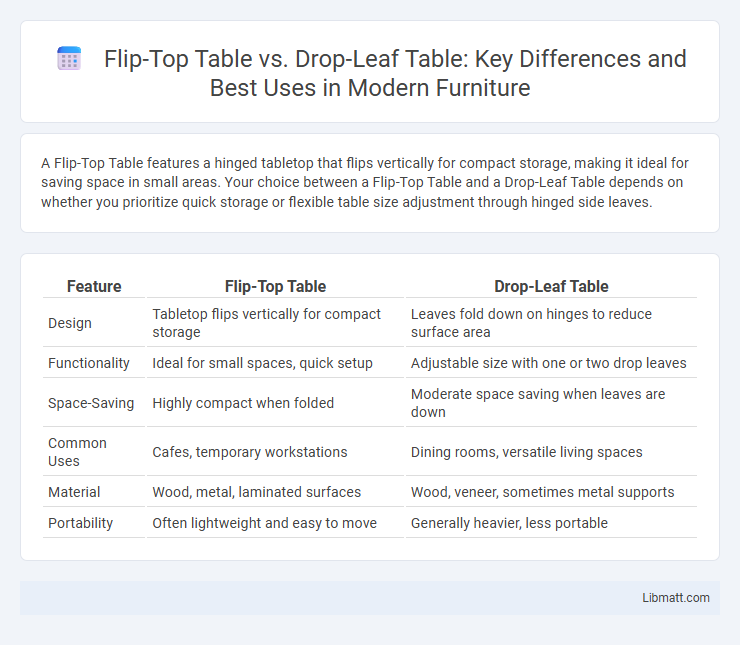A Flip-Top Table features a hinged tabletop that flips vertically for compact storage, making it ideal for saving space in small areas. Your choice between a Flip-Top Table and a Drop-Leaf Table depends on whether you prioritize quick storage or flexible table size adjustment through hinged side leaves.
Table of Comparison
| Feature | Flip-Top Table | Drop-Leaf Table |
|---|---|---|
| Design | Tabletop flips vertically for compact storage | Leaves fold down on hinges to reduce surface area |
| Functionality | Ideal for small spaces, quick setup | Adjustable size with one or two drop leaves |
| Space-Saving | Highly compact when folded | Moderate space saving when leaves are down |
| Common Uses | Cafes, temporary workstations | Dining rooms, versatile living spaces |
| Material | Wood, metal, laminated surfaces | Wood, veneer, sometimes metal supports |
| Portability | Often lightweight and easy to move | Generally heavier, less portable |
Introduction to Flexible Table Designs
Flip-top tables feature hinged tabletops that fold vertically for compact storage, ideal for maximizing space efficiency in small rooms or multi-use areas. Drop-leaf tables have hinged sections on either side that can be extended or lowered to adjust the surface area, offering versatile seating capacity when needed. Your choice between these flexible table designs depends on how much space you need to save and the frequency of expanding your table surface.
What is a Flip-Top Table?
A Flip-Top Table features a hinged tabletop that folds vertically, allowing for compact storage and easy mobility, ideal for small spaces or multifunctional rooms. This design maximizes space efficiency by enabling the table to be quickly collapsed against a wall or stored away when not in use. Your choice of a Flip-Top Table offers versatility and convenience, perfect for flexible living or working environments.
What is a Drop-Leaf Table?
A drop-leaf table features hinged sections on either side that can be folded down to save space or extended to increase surface area, making it ideal for compact living environments. This design allows for flexible functionality, accommodating varying needs such as dining, working, or additional seating. Drop-leaf tables often showcase classic craftsmanship and are available in a variety of materials like solid wood, making them a versatile choice in both traditional and modern decor.
Space-Saving Benefits Compared
Flip-top tables maximize your space by allowing the tabletop to fold vertically, making them ideal for tight areas or compact living rooms. Drop-leaf tables offer adjustable surface size with hinged leaves that swing down to save floor space but require clearance around the table edges when open. Both designs prioritize space efficiency, but flip-top tables provide a more streamlined footprint when not in use, while drop-leaf tables offer versatile expansion for seating or work surfaces.
Design and Aesthetic Differences
Flip-top tables feature a hinged tabletop that folds vertically for compact storage, offering a sleek, modern design suitable for minimalist spaces. Drop-leaf tables have hinged sections on either side that can be extended or folded down, creating a classic, versatile look often favored in traditional or rustic interiors. Your choice depends on whether you prefer the streamlined appearance of a flip-top or the adaptable charm of a drop-leaf design.
Functional Versatility: Flip-Top vs Drop-Leaf
Flip-top tables offer exceptional functional versatility by allowing the tabletop to fold vertically, making storage and space-saving effortless, especially in compact living areas. Drop-leaf tables feature hinged sections on either side that can be lowered or raised to quickly expand or reduce surface area, providing adaptable dining or workspace options. Your choice depends on whether you prioritize easy vertical folding for storage (flip-top) or adjustable horizontal expansion for added surface space (drop-leaf).
Durability and Maintenance Considerations
Flip-top tables typically offer superior durability due to their sturdy hinge mechanisms and solid frames, making them ideal for frequent use and easy movement. Drop-leaf tables, while space-saving, often require more careful maintenance to ensure the hinges and leaves remain secure and free from warping. Your choice depends on how much maintenance effort you're willing to invest and the durability needed for your daily use.
Usage Scenarios and Room Suitability
Flip-top tables offer versatile usage for small apartments, home offices, and meeting rooms where space-saving and quick setup are essential, particularly in spots with limited floor space like studios or multi-purpose rooms. Drop-leaf tables are ideal for dining areas and kitchens that require flexible seating arrangements, expanding easily to accommodate guests while fitting compactly against walls when not in use. Both table types suit environments needing adaptability but vary in mechanism and space impact, with flip-top tables emphasizing portability and drop-leaf tables providing adjustable surface area.
Price and Value Comparison
Flip-top tables generally offer better value for small spaces due to their compact, foldable design and affordability, with average prices ranging from $100 to $300. Drop-leaf tables, often crafted from solid wood, tend to be pricier, typically costing between $200 and $600, but provide greater versatility and long-term durability. The choice depends on budget constraints and intended use, where flip-top tables prioritize space-saving at a lower cost while drop-leaf tables deliver enhanced functionality and investment value.
Which One Should You Choose?
Flip-top tables offer quick and easy storage with a hinged tabletop that folds vertically, making them ideal for small spaces requiring frequent reconfiguration. Drop-leaf tables provide expanded surface area when needed, using side leaves that fold down, perfect for versatile dining or workspace setups. Choose a flip-top table for compact, efficient space-saving solutions, while a drop-leaf table suits users needing adjustable table size for varying activities.
Flip-Top Table vs Drop-Leaf Table Infographic

 libmatt.com
libmatt.com